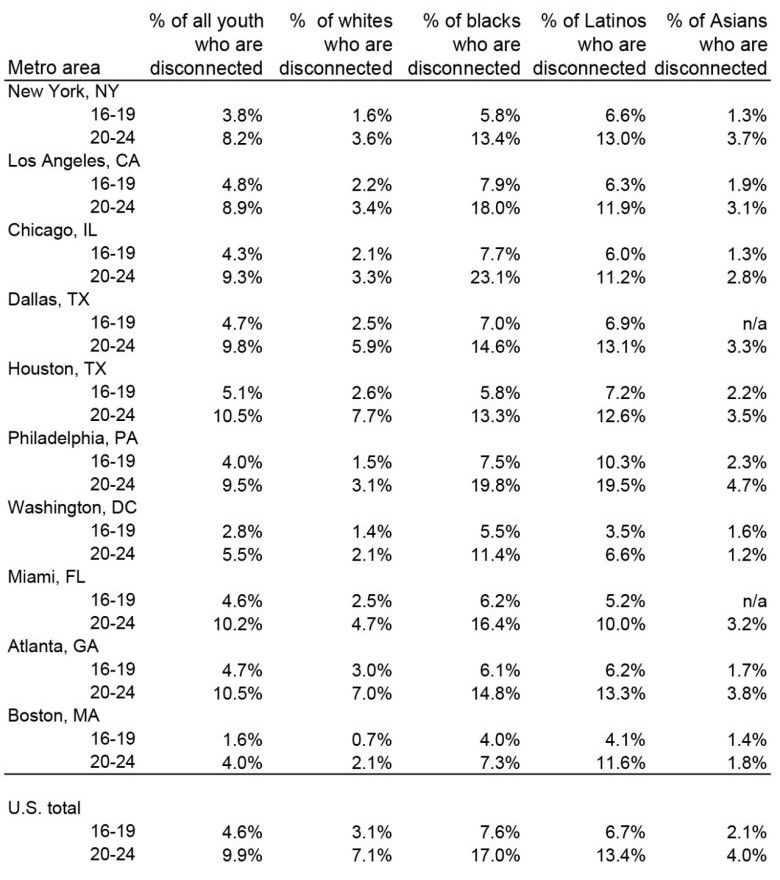Workforce Development for Chicago’s Youth
The definition of ‘workforce development’ is broad, and there are many programs that focus on the different aspects of the field. Recently, CDPS posted two workforce-focused blogs: (1) Workforce Development for the Next Generation: Early Childhood Education and (2) Investing in America’s Workforce. CDPS will continue to explore the topic from different perspectives. This blog will look at youth unemployment, specifically through the lens of Skills for Chicagoland’s Future (Skills) Beyond the Diploma program.
With the labor market at what many economists might consider maximum employment (5 percent unemployment is the rule of thumb for ‘full employment’ and the latest data from January 2018 show the nation at 4.1 percent), a close look is warranted at the segments of the working-age population who are unemployed. One such segment is young adults between the ages of 16 and 19. Addressing youth unemployment is especially important given the drastically higher unemployment rate for youth (white 12.4 percent) and black youth in particular (24.3 percent) as compared to the rates for whites and blacks on average (i.e., irrespective of age), which are 3.5 percent and 7.7 percent, respectively.
1: Unemployment rates

Looking beyond the unemployment figures, the share of teens in the labor force (employed or looking for employment) has fallen precipitously – just 43 percent of teens had a job in July 2016, compared to 72 percent in 1978. The Brookings Institution recently highlighted the importance of reconnecting youth to employment in its report Employment and disconnection among teens and young adults: The role of place, race, and education. It discusses “disconnected youth,” defined as those neither working nor in school. These youth “are at risk for a host of negative outcomes: long spells of unemployment, poverty, criminal behavior, substance abuse, and incarceration.” While Chicago has a lower share of disconnected youth in both age groups compared to the U.S., a closer look reveals, the share of disconnected black youth is higher in both age groups as compared to the U.S.
2. Share of youth who are disconnected by age and race/ethnicity, ten largest metropolitan areas, 2012-2014

Skills is trying to address the gap in employment attainment for youth in Chicago through a new, employer-driven approach. Skills is a public-private partnership working to match businesses that have current, unmet hiring needs with qualified, unemployed and underemployed job seekers. Skills spent time in late 2016 analyzing both primary and secondary research on trends in youth unemployment, which yielded four key findings:
- Lack of Exposure – Younger teens (age 16 – 19) are now participating in the labor force at much lower levels than previous decades, with potentially detrimental effects of not gaining early, formative work experiences.
- “College for All” Mentality – For high school students the emphasis on college preparation appears in some cases to have crowded out career planning for those not headed to college. As a result, awareness of alternative pathways, or even how to balance both work and post-secondary education, remains low among high school students.
- Workplace Conflict Resolution – Young adults experience unique challenges navigating workplace relationships, conflicts and professional norms, creating additional barriers to retaining employment.
- A Degree is Not a Silver Bullet – College degrees do not necessarily translate into meaningful careers, especially for low-income and/or first generation college students, and little support is available to help those with limited experience secure employment commensurate with their educational attainment.
The result of the analysis and these findings was a new programmatic approach called “Beyond the Diploma” aimed at youth from high school students through college graduates. Skills based the program on a single guiding hypothesis: an employer-driven approach that results in a real, committed job – coupled with soft skills training, mentorship and support necessary to persist in employment – will create positive impact for both young adults and businesses.1
These four findings inform a three-pronged approach that focuses on three distinct groups with different needs: “Jobs 101” for high school students; “Pivot to Success” for high school graduates; and “U 2.0” to serve college graduates.
Jobs 101: Given the push for higher education, even though many students will not attend college, career planning in high school has historically been overlooked. Jobs 101 will create a solution for these issues, bringing career preparation into high schools to complement the college counseling students receive. Juniors and seniors would receive education on job readiness, including how to: apply for a job, write a resume, interview and negotiate an offer. Students would also have the opportunity to engage directly with employers through site visits to learn about different career pathways. Ultimately, Skills will also place students in both part-time/summer jobs while they are in high school, as well as connect them to full-time jobs with career pathways if they choose not to pursue college (immediately).
Pivot to Success: Pivot to Success will target youth ages 18 – 24 with a high school degree or a GED that are neither working nor attending college full-time. Skills is partnering with committed employer partners to place youth adults into entry-level jobs with defined career advancement opportunities. Youth will also have the opportunity to advance their education through college or industry credential training, and receive mentoring support to address barriers they may face in persisting in either work or school.
U 2.0: U 2.0 is aimed at youth that have graduated from college with a two- or four-year degree, but need additional support and preparation in finding and transitioning into a job. Skills will partner closely with both employers and higher education partners to prepare and connect graduates to meaningful first jobs. Graduates with few barriers to entry will be directly connected into employers, while those lacking the necessary soft skills will receive “boot camp” training to prepare them to interview, obtain, and succeed in jobs.
This three-pronged approach has the potential to help more youth in Chicago secure not only a job, but a career that will improve their economic trajectory.
1 https://www.skillsforchicagolandsfuture.com/news/mayor-emanuel-and-skills-for-chicagolands-future-announce-new-initiative-to-place-unemployed-youth-into-jobs-with-career-pathways-and-higher-education/








